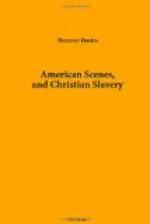In quoting this, an American writer adds, “He had not yet learned, if he ever did, that God is not pleased to make such ‘sweet couples’ out of persons who have no choice of their own.”
Mr. Edwards, junior, or rather Dr. Edwards, was (like his father) a great scholar and a profound divine. He was frequently invited to assist at the examinations in Yale College. On those occasions he used frequently to display his strictness and accuracy by calling out, “Haud recte” (not right). This procured him the sobriquet of “Old Haud Recte,” by which he was afterwards known among the students. Some time after his resignation of the pastorate of this church he became the President of Union College. His works have recently been published in two large octavo volumes. There is a striking parallel between the father and the son. They were alike in the character of their minds and in their intellectual developments. The name, education, and early employments of the two were alike. Both were pious in their youth; both were distinguished scholars; both were tutors for equal periods in the colleges where they were respectively educated; both were settled in the ministry as successors to their maternal grandfathers; both were dismissed, and again settled in retired places, where they had leisure to prepare and publish their works; both were removed from those stations to become presidents of colleges; both died shortly after their respective inaugurations, the one in the 56th and the other in the 57th year of their age; and each of them preached on the first Sabbath of the year of his death from the same text—“This year thou shalt die!”
But we must not dwell too long on these historical incidents. I have told you something about the Centre Church and the North Church. That Gothic building on our left is an episcopal church. That white building immediately in the rear of the Centre Church is the State House, completed in 1831. It is constructed of stone and marble, and forms a prominent ornament of the city. It presents one of the best copies of a Grecian temple I have seen in the States. In the rear of the North Church, quite at the remote corner of the Green, stands a plain barn-like Methodist chapel. And, behind the whole, peeping through the elm-trees, you see the long range of buildings which constitutes Yale College. Take it all in all, a view more interesting than that from the spot on which we now stand I have never beheld.




